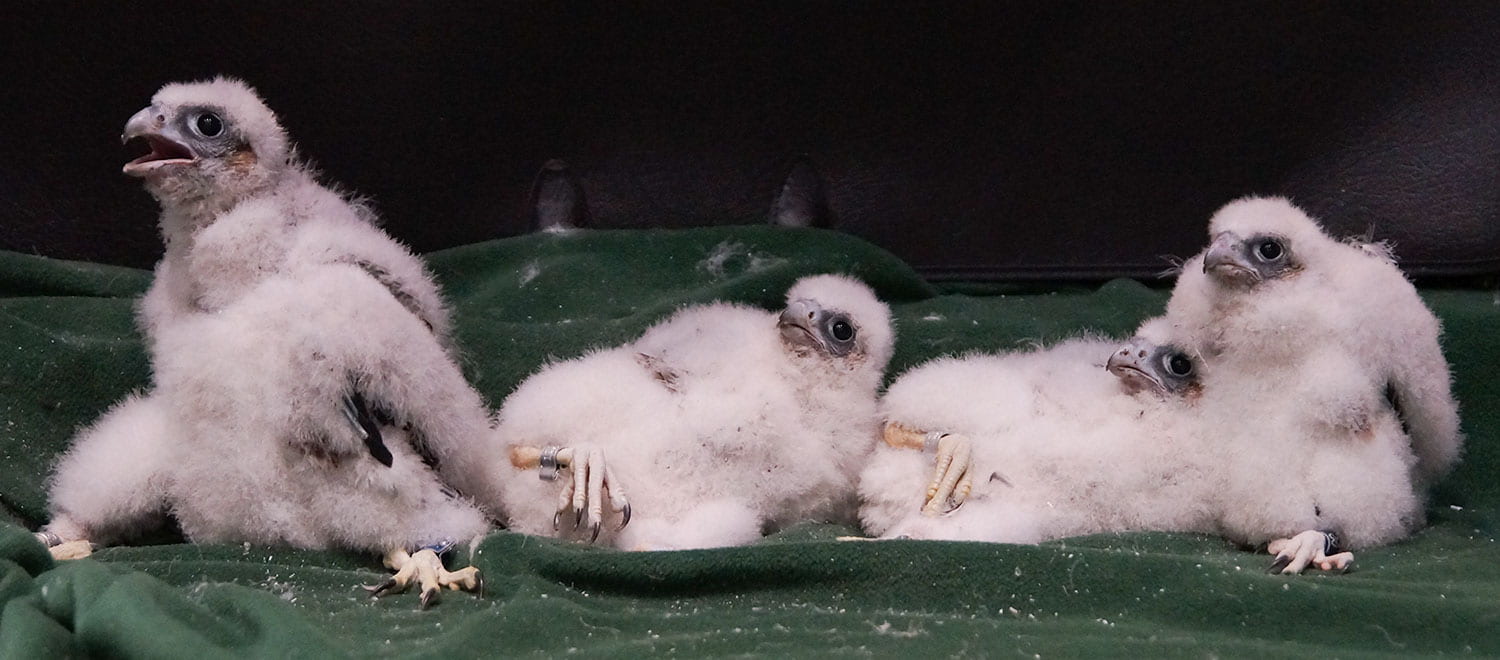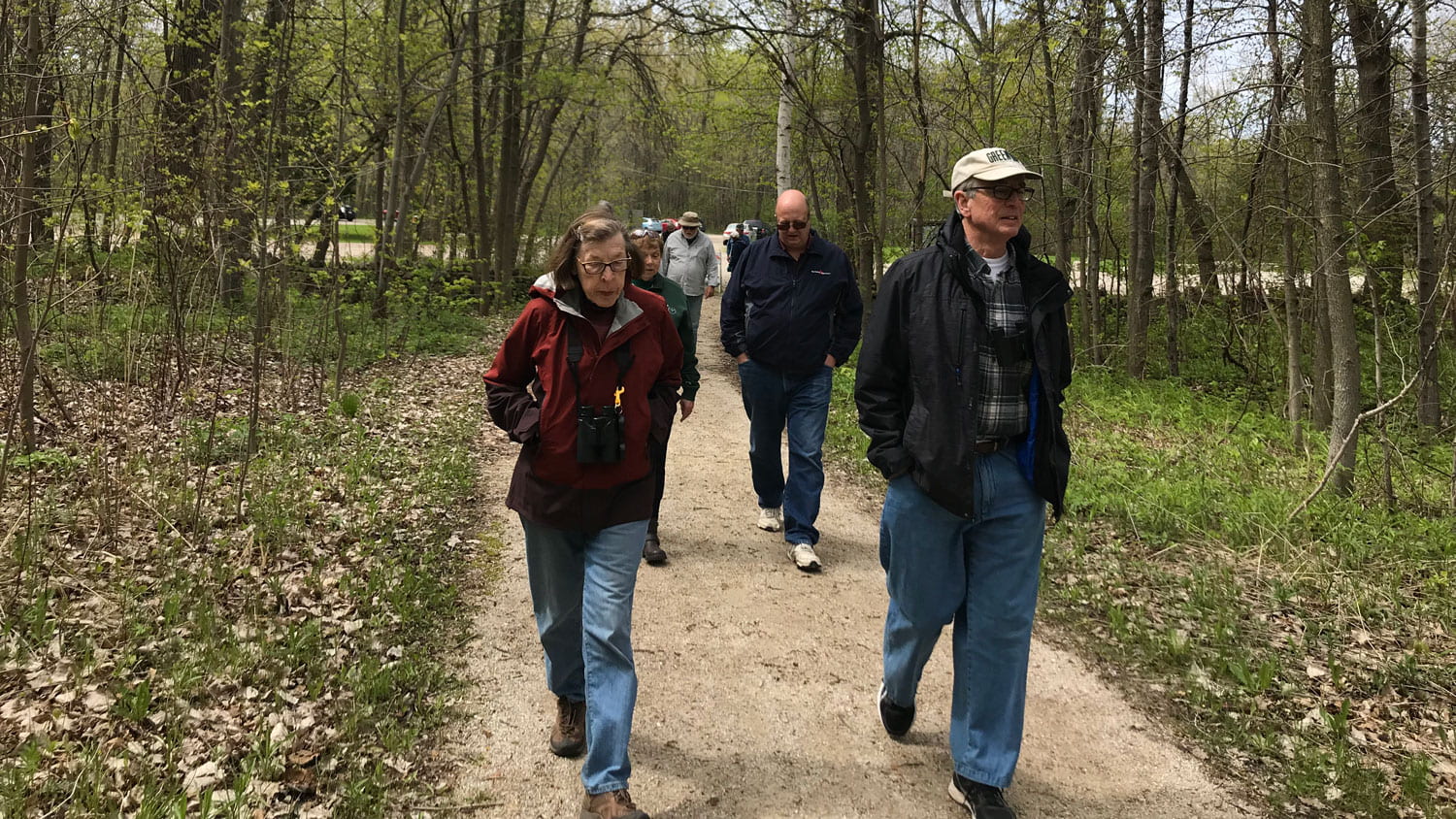Falcon Photo-Op Day (and Naming Ceremony) is also an educational opportunity

On Thursday, May 30, 2019, Cofrin Library rolled out the green carpet to greet the latest additions to UW-Green Bay’s feathered family. A flock of nearly 100 bird-lovers gathered in the library pavilion for the third annual debut party of Mimi and Rupert’s offspring. This marks the third consecutive year, with successful nests in 2017, 18 and 19.
At a long table, Greg Septon, “founding father” of Wisconsin Peregrine Falcon Recovery Project and UW-Green Bay Prof. Amy Wolf (Biology) co-hosted the ceremony. Septon extracted each chick, or eyass (pronounced ‘eye-yass’), from a single pet carrier, announced the gender and then attached bands to each leg with a pop rivet. Wolf, christened each with a ceremonial name. Once completed, it was back into the container and the next one fetched for the adoring crowd.
Bird one was extracted from the carrier. A big ball of down perched on near fully-grown legs.
Septon delivered the news: “It’s a male.”
“We’re naming the birds after prominent conservation biologists,” Wolf announced, “so this one’s name is Leopold, for Aldo Leopold.”
For those who have made the trek up to UW-Green Bay’s Provost Office or over to Mary Ann Cofrin Hall to view the webcam broadcast of the blue jay-feather-festooned nesting box (Peregrine’s favorite meal), quickly notice these birds appear much larger face- to-face than on the screen.
Wolf has her theories why blue jays are a family favorite… “They’re very conspicuous and larger, so they’re a good meal.” Adding that on observation of all nesting Peregrine falcons in the area, blue jays are a preferred entrée.
“Alright. One down.” Septon tells the crowd. It’s time for the reveal of bird No. 2. Despite their downy appearance, leather gloves protected Septon from the young raptor’s sharp talons and beaks.
Another male.
“That one’s Muir, for John Muir.” (An influential Scottish-American naturalist also known as “Father of National Parks.”) Wolf informed the crowd.
The next bird out was bigger, louder and considerably more displeased with the events.
“Anyone want to guess the sex?” Septon offered. The crowd laughs a little. “The females are always louder and a little more difficult to deal with.” The crowd groaned a little. He quickly added “Only Peregrine. It’s always true.”
“Rachel,” Professor Wolf announced “for (nature writer) Rachel Carson.”
“OK, one more.” Septon fished out the final falcon, a male, christened Thoreau. Banding completed, it was time for the photo op, but not before a bit of cautionary advice from Septon. “You can get relatively close but every once in a while, a chick decides it’s going to run. If that happens, everyone just freeze,” he advised. None made a break for it while cameras and cellphones record the events.
And as far as getting the birds back to the roof, that task falls to current Biology students Brandon Byrne and Noah Nie. They’ve been in charge of maintaining the nesting box. For them, the process has been both a labor of bird-loving and a serious learning experience.
“They’ve been fun to watch. Going from unhatched eggs to today.” Nie says. “A lot of our research is on nest behavior. How both parents interact with the young.”
Branden also notes that the adult bird interaction has had its dramatic moments. “There was another (banded) female from Milwaukee, named Bratcha, who showed up when Mimi went missing. For a while, we thought, ‘oh no.’ There had been a pretty bad snow storm in January or February. But then Mimi came back and Bratcha left.”
All the televised research and intrigue would have not been possible without the technical expertise of recent graduate Jacob Woulf ’19 (Biology) who devised and installed “Peregrine Cam” with funding assistance from avid community birders Paul and Annie Mueller.
Though the nest will soon be empty, research continues with Byrne, Nie and Woulf assisting Prof. Wolf. “ All three students are continuing to work with me on a research project aimed at describing the behaviors of the Peregrine based on stored video footage. Ultimately, we hope to submit a research paper based on the results.”
It’s obvious these birds did not crave the spotlight. In fact, their celebrity status is fleeting. In a week or two, flight feathers will have completely replaced down and Leopold, Muir, Rachel and Thoreau will have flown their nesting box.
Offspring are not welcomed back home. But one of the benefits of banding is that these birds can be tracked. (One offspring is reported to have a nest in Eau Claire.) Plus the webcam has been a valuable research tool for students studying nesting, incubating and feeding behavior. As for Mimi and Rupert? If recent history is any indication, they won’t stay empty-nesters for long. Stay tuned for next season…
This public event was a quiet kick-off to the Cofrin Center for Biodiversity’s 20th Anniversary year of celebration. Details TBA.
Click to advance slideshow or view the album on Flickr.

– Story by Michael Shaw; Photos and video by Daniel Moore




